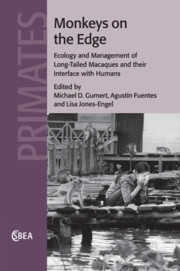Book contents
- Frontmatter
- Contents
- List of contributors
- Foreword
- Preface
- Acknowledgements
- Part I The status and distribution of long-tailed macaques
- 1 The common monkey of Southeast Asia: Long-tailed macaque populations, ethnophoresy, and their occurrence in human environments
- 2 Distribution and current status of long-tailed macaques (Macaca fascicularis aurea) in Myanmar
- 3 Distribution and present status of long-tailed macaques (Macaca fascicularis) in Laos and their ecological relationship with rhesus macaques (Macaca mulatta)
- Part II The human–macaque interface
- Part III Ethnophoresy of long-tailed macaques
- Part IV Comparisons with rhesus macaques
- Part V Understanding and managing the human–macaque interface
- Index
- References
1 - The common monkey of Southeast Asia: Long-tailed macaque populations, ethnophoresy, and their occurrence in human environments
from Part I - The status and distribution of long-tailed macaques
Published online by Cambridge University Press: 16 May 2011
- Frontmatter
- Contents
- List of contributors
- Foreword
- Preface
- Acknowledgements
- Part I The status and distribution of long-tailed macaques
- 1 The common monkey of Southeast Asia: Long-tailed macaque populations, ethnophoresy, and their occurrence in human environments
- 2 Distribution and current status of long-tailed macaques (Macaca fascicularis aurea) in Myanmar
- 3 Distribution and present status of long-tailed macaques (Macaca fascicularis) in Laos and their ecological relationship with rhesus macaques (Macaca mulatta)
- Part II The human–macaque interface
- Part III Ethnophoresy of long-tailed macaques
- Part IV Comparisons with rhesus macaques
- Part V Understanding and managing the human–macaque interface
- Index
- References
Summary
The long-tailed macaque (Macaca fascicularis) population spreads over one of the widest geographical ranges of any primate, trailing only humans (Homo sapiens) and rhesus macaques (M. mulatta) (Wheatley,1999) (Figure 1.1). According to Fooden (1995, 2006), the population extends across the majority of mainland Southeast Asia. They occur in the southeastern most part of Bangladesh, spreading south along the coast of Myanmar, east through the southern two-thirds of Thailand, all of Cambodia, the southeastern tip of Laos, and through the southern half of Vietnam. Through Thailand, the population extends past the Isthmus of Kra, and occurs all through Sundaland (i.e., peninsular Malaysia and the Indonesian archipelago west of the Wallace line) and into the Philippines. Long-tailed macaques also occur on smaller islands. For example, long-tailed macaques occur off the northern coast of Sumatra on the most southern Indian Nicobar Islands, as well as occurring on small islands off the west coast, such as Simeulue and Lasia. Other island habitats include Maratua, off Kalimantan, Karimunjawa, off Java, Koh Khram Yai, off Thailand, and Con Son, off Vietnam. They certainly occur on many other small islands, as the region is covered with tens of thousands of islands.
Long-tailed macaques are found predominantly on the western side of the Wallace line and are considered Asian fauna. Despite this, populations in Wallacea exist on the eastern side of the line, which are possibly the result of historical human introductions (e.g., Lombok, Nusa Tenggara, and East Timor) (Kawamoto et al., 1984).
- Type
- Chapter
- Information
- Monkeys on the EdgeEcology and Management of Long-Tailed Macaques and their Interface with Humans, pp. 3 - 44Publisher: Cambridge University PressPrint publication year: 2011
References
- 30
- Cited by



